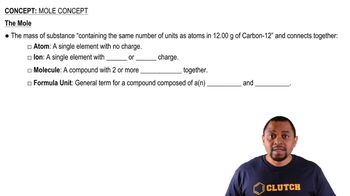Calculate the mass (in kilograms) of chlorine in 25 kg of each chlorofluorocarbon (CFC). b. CFCl3
Ch.3 - Molecules, Compounds & Chemical Equations
Chapter 3, Problem 87
A chemist decomposes samples of several compounds; the masses of their constituent elements are listed. Calculate the empirical formula for each compound. a. 1.651 g Ag, 0.1224 g O b. 0.672 g Co, 0.569 g As, 0.486 g O c. 1.443 g Se, 5.841 g Br
 Verified step by step guidance
Verified step by step guidance1
Step 1: For each compound, convert the mass of each element to moles by dividing by the element's molar mass. For example, for Ag, use the molar mass of silver (107.87 g/mol).
Step 2: Determine the mole ratio of the elements by dividing each element's mole value by the smallest number of moles calculated in the previous step.
Step 3: If necessary, multiply the mole ratios by a whole number to obtain whole numbers for each element in the compound. This will give you the subscripts for the empirical formula.
Step 4: Write the empirical formula by placing the whole number ratios as subscripts next to each element symbol.
Step 5: Repeat the process for each compound listed in the problem to find their respective empirical formulas.

Verified video answer for a similar problem:
This video solution was recommended by our tutors as helpful for the problem above.
Video duration:
2mWas this helpful?
Key Concepts
Here are the essential concepts you must grasp in order to answer the question correctly.
Empirical Formula
The empirical formula of a compound represents the simplest whole-number ratio of the elements present in that compound. It is determined by converting the masses of each element into moles and then simplifying the mole ratios to the smallest integers. This formula provides essential information about the composition of the compound without indicating the actual number of atoms in a molecule.
Recommended video:
Guided course

Empirical vs Molecular Formula
Mole Concept
The mole is a fundamental unit in chemistry that quantifies the amount of substance. One mole corresponds to Avogadro's number, approximately 6.022 x 10²³ entities (atoms, molecules, etc.). To calculate the empirical formula, the mass of each element is converted to moles using its molar mass, allowing for the comparison of the relative amounts of each element in the compound.
Recommended video:
Guided course

Mole Concept
Molar Mass
Molar mass is the mass of one mole of a substance, typically expressed in grams per mole (g/mol). It is calculated by summing the atomic masses of all the atoms in a molecule. Knowing the molar mass of each element is crucial for converting the mass of each element in a sample to moles, which is a necessary step in determining the empirical formula.
Recommended video:
Guided course

Molar Mass Concept
Related Practice
Textbook Question
1
views
Textbook Question
How many fluorine atoms are present in 5.85 g of C2F4?
1
views
Textbook Question
How many bromine atoms are present in 35.2 g of CH2Br2?
1
views
1
rank
Textbook Question
A chemist decomposes samples of several compounds; the masses of their constituent elements are listed. Calculate the empirical formula for each compound. a. 1.245 g Ni, 5.381 g I
Textbook Question
A chemist decomposes samples of several compounds; the masses of their constituent elements are listed. Calculate the empirical formula for each compound. b. 2.677 g Ba, 3.115 g Br
Textbook Question
A chemist decomposes samples of several compounds; the masses of their constituent elements are listed. Calculate the empirical formula for each compound. c. 2.128 g Be, 7.557 g S, 15.107 g O
1
views
